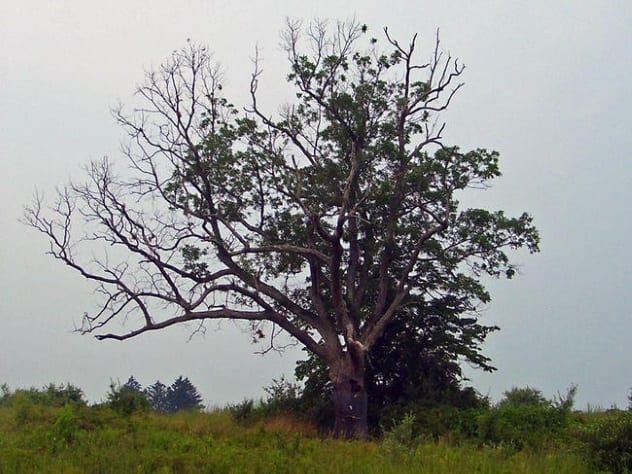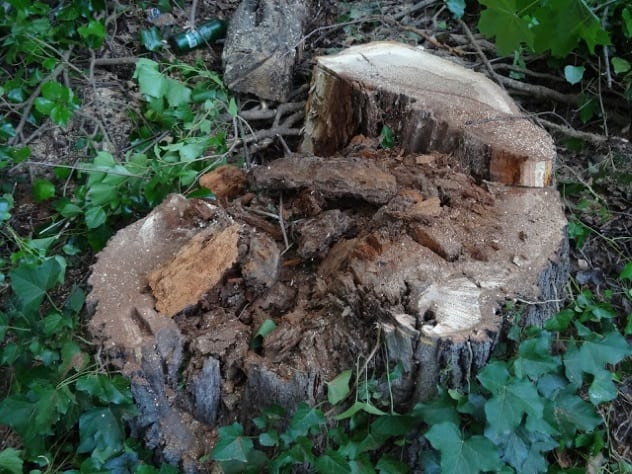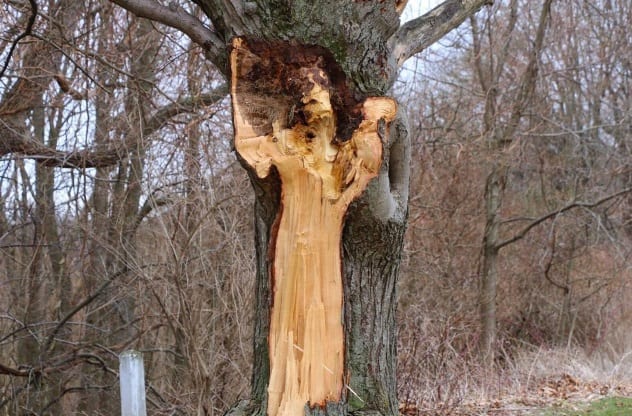Nevertheless, many of us have been scared by a tree at some point or another—one with a sinister shape at night or a face-like feature we didn’t expect or scratching at the window in the dark. These examples are just people freaking themselves out, of course, but there might be something more than that to the following trees . . .
10 An Unbelievable Story
In 1874, newspapers throughout the United States reported an amazing, and horrific, new discovery on the island of Madagascar off the coast of Africa: a man-eating tree! A letter from a scientist visiting the island described the strange plant as having a trunk much like a huge pineapple, dark in color and hard as iron. From the top of the plant extended eight gigantic, stiff leaves. The top also featured a bowl, full of a sweet-smelling liquid, surrounded by green and white tendrils that waved in the air like snakes. The scientist’s first observation of one of these strange plants was interrupted by the local tribesmen forcing a young woman at spearpoint to the top of the tree, where the white and green tendrils grabbed her; then the gigantic leaves all slowly raised up and clamped closed around the young woman at the top of the tree. As the great leaves crushed her body, blood and sap started to dribble down the trunk of the dreadful tree. The tribesmen reportedly jumped forward to catch this in containers or just lick it from the trunk directly, all becoming horribly drunk from it. The scientist quickly left the macabre party. It took ten days for the tree to reopen, and the bones of the woman now lay at its base under the great leaves. A later observation by the scientist of some smaller trees of this variety allowed him to witness the death of a playful lemur that got too close to the carnivorous trees; it seemed likely these tree-dwelling primates were the actual main prey of the horrid plants.[1] This strange account—unbelievable though it might sound—was believed for quite a while; after all, few people could go to Madagascar to double-check it. Eventually, however, the truth came out. The account had been written by a bored reporter looking for an interesting story. The man-eating tree of Madagascar had never existed, but, ironically, interest in the fictional tree greatly accelerated the exploration of the actual island!
9 A Bad Choice
In March 1950, a 300-year-old thorn tree was accidentally destroyed by a bulldozer in a field just outside of Fintona, Ireland. The locals immediately predicted that trouble would follow, for the tree had been a “fairy thorn,” a tree known for fairy activity. A 72-year-old pensioner named James McAnespie bought some of the bulldozed fairy tree to use as firewood, and as soon as he started to use this wood in his fireplace, odd things began to happen. Bells started to chime in different parts of his house. He started to see small flying things that he couldn’t ever seem to catch. On Sunday, April 16, McAnespie used the last of the fairy tree wood he had and decided to go get more. As night fell, his neighbors realized he had never returned home, so they went out to search for the elderly man. When they couldn’t find him, they quickly alerted the police, and a large search party of police and civilians set out into the night to find McAnespie. The searchers covered a good part of the town and surroundings, calling for McAnespie but getting no response. At 11:30 PM, McAnespie was found; he was standing motionless in a field just outside of town . . . on the very spot where the fairy tree had stood before being bulldozed. McAnespie didn’t respond or react to the searchers’ calls, but when they came near him, the elderly man turned and walked to them and then walked back to the village with them. McAnespie said that he’d gone to the field to gather sticks and branches from the area where the fairy thorn had stood. He then tied the wood into a bundle. As it was getting dark, he started to walk home, only to find himself frozen, unable to move or speak. He estimated he was frozen in place for about two hours. McAnespie said he heard bells ringing around his feet. He could see a ditch of some sort around himself, there was a big house or barn with its lights on a short distance away that shouldn’t have been there, and he saw two “wee fellows”—fairies! Despite hearing and seeing the people searching for him, McAnespie had been unable to move until the search party came close to him.[2]
8 Something Wicked
In Somerset County, New Jersey, US, is a tree with an evil reputation. Legends claim the Ku Klux Klan lynched untold numbers of African Americans from its branches, that a farmer murdered his family under it before hanging himself from one of the branches, or both. But these are just guesses at possible explanations for what is actually known about this bizarre tree: Very strange things happen to those who interact with what has come to be called the “Devil’s Tree.” Some rather interesting personal accounts have been posted to the Internet. One person who climbed the tree said he heard noises coming from within it as he sat on a branch. These noises grew louder until a big bang sounded, and he was thrown to the ground, breaking his ankle in two spots. A teen who doubted the rumors about the tree took the time to stop his car on the road near it, run over to urinate on the tree, and then drive off presumably laughing . . . until his car uncontrollably accelerated on its own and crashed into another tree! Some people assert that voices can be heard screaming inside the tree. One visitor who decided to take a piece of bark home as a souvenir started to see the specter of an old man near his bed at night. (Hopefully he took the bark back at some point.) Finally, another visitor reported that he went to see the tree with friends and took a picture of it with a Polaroid camera. When the picture finished developing about a minute later, on the right side of the tree was the clear image of a woman in a red dress hanging from a branch by a noose.[3]
7 Ignored Warnings
In 2013, New York City had a problem in its parks, one that was being quietly ignored. On July 20, it was reported that a 13-year-old girl was struck on her shoulder and back by a falling tree branch while at Riverside Park, and her injuries were such that she was rushed to a nearby hospital. In the same report, two more facts came out: The Parks Department was refusing requests by reporters for details on the incident, and six other people had been hit by falling branches at different parks in the city over the previous six weeks. On July 14, a 51-year-old man had been hit by a large branch at Union Square Park. He was relaxing with his family in the shade of an elm when a 6-meter-long (20 ft) branch fell and hit him; he was also rushed to a hospital. The day after that, a five-year-old boy was hit by a falling branch at Bronx Park. Luckily, he wasn’t seriously injured. These were preceded by multiple similar reports in the month of June . . . and all of this was in the wake of a massive settlement of $11.5 million to a man who had been struck in the head by a falling branch at one of the parks, as well as a New York Times expose from the year before detailing a new record high in deaths caused by falling branches. You would assume that the city would take some action to fix the problem. But they didn’t. On August 4, 2013, soon-to-be-mother Yingyi Li-Dikov was sitting on a bench with a friend in Flushing’s Kissena Park, when “there was a loud crack and a screeching noise,” as reported by a witness who ran over to see what made the noise. The source of the sound was a tree that had just fallen on the bench Li-Dikov and her friend were sitting on. Half of the bench had been destroyed—the half Li-Dakov had been sitting on. She had been struck on the head and shoulders and was bleeding profusely when emergency personnel pulled her free. They rushed her to a hospital, but Li-Dikov was declared dead on arrival. Her friend escaped with only minor injuries and refused medical attention.[4] Even as city officials tried to attribute the incident to an “act of God,” photos of the tree’s rotted base started to circulate on the Internet. The tree hadn’t fallen purely by accident; it had fallen due to a lack of maintenance, which was exactly why branches were falling at other parks throughout the city. The only real accident that day was that Yingyi Li-Dikov had sat on the bench at the wrong time.
6 Venus Cow Trap?
On October 18, 2007, a young woman named Pushpalatha was walking through the thin forest that blends with the village of Patrame, India, when she ran across an incredible sight: A short tree in the forest was apparently trying to lift a cow off the ground by its hindquarters! The cow’s tail and hind legs were entangled by the branches, with just the animal’s front legs still on the ground. The cow was actively trying to pull away from the plant, and the tree clearly appeared to be pulling the cow back! Pushpalatha ran for help, and soon, a local farmer named Vasanna was trying to free the animal by cutting branches off the tree. It wasn’t until the tree was just plain cut down that it released its grip on the animal. Farmers in the area had been complaining about cows returning home with tails missing and/or wounds on their backs, but they hadn’t suspected there was a pili mara—“tiger tree”—in the area until Vasanna had to cut the tree down. Another villager recalled that there had been another such tree in the area 30 years previously, and it was clear from how the whole matter was discussed that pili mara were not a particular type of tree but rather a tree possessed by some sort of spirit.[5] The press loved the story, quickly dubbing this new terror the “Cow-Eating Tree.”
5 Ghost In The Shell
For years, people had talked of the rumored ghost of Durand-Eastman Park in Rochester, New York, US. Known as “The White Lady,” she is said to be a woman from the 19th century whose spirit wanders the park at night trying to find the body of her daughter, slain by either her boyfriend or a group of hoodlums. The White Lady herself is believed to have either committed suicide out of grief or to have died alone and heartbroken while searching for her lost child. The White Lady has reportedly been seen rising from the water in the park, and some say they have seen her with two spectral hounds. One local resident told reporters that he and a friend were in a car late at night in the park when he saw the face of an unknown woman in white in his rearview mirror staring at him from behind a tree. As you might guess, the reported ghost had a long history with the park. And then it got weirder. In 2017, a storm tore a great chunk of wood from a tree in the park and ended up adding a new element to the story of the resident ghost, for revealed in the newly exposed wood of the tree was a ghostly shape that many identify as that of the White Lady herself. The shape exposed is described as that of a woman with a skull-like face, wearing a dress and stretching her arms over her head. Some say this figure appears to be holding a baby, presumably representative of the missing daughter. This figure wasn’t carved; it’s the result of a natural break and an unusual pattern of colors within the wood of the tree itself, making the resemblance to the local legend just plain creepy. Though damaged, the tree isn’t in danger of falling over, so the newfound image of the White Lady will stand in memory of the ghostly legend for some time.[6]
4 Secret In The Wych Elm
On April 18, 1943, four boys were in Hagley Wood in Worcestershire, England, hunting for bird’s nests, when they found a particularly good-looking large wych elm tree that they figured had to have some nests in it. One of the boys was climbing up the tree when he discovered it had a hollow area that could be seen inside of from above, and there was something in it. He reached in and pulled out a human skull, with traces of hair still attached. The boys were in the woods illegally—it was part of the estate of Hagley Hall—so they all immediately agreed to not tell anyone what they had found. Naturally, one of the boys told someone. Police found that the hollow of the tree contained a near-complete skeleton, along with a shoe, gold wedding ring, and some remaining fragments of clothing. In addition, the remains of a human hand were found on the forest floor at some distance from the tree. Analysis determined the body was that of a female who had died at least 18 months earlier (around October 1941). Other evidence suggested that she had been suffocated and shortly afterward stuffed in the tree hollow, before rigor mortis set in. It was definitely a murder. The police tried to identify the woman from what the clothing evidence told them and from her teeth, but due to the ongoing war, there were just too many people who had gone missing or had been displaced for any identification to be determined. Stranger still, a piece of graffiti appeared: “Who put Bella down the Wych Elm—Hagley Wood.” It was found in Birmingham, around 18 kilometers (11 mi) away from Hagley Wood. Then more appeared around the area, seemingly written by the same person. Attempts to find the writer of the messages failed, as did attempts to identify “Bella.” To this day, the true identity of Bella is unknown . . . and people continue to place graffiti on the obelisk erected as a monument to the mystery near the location of the discovery, repeatedly tagging it with the question, “Who put Bella in the Wych Elm?”[7]
3 Remaining Remains
Roger Williams (1603–1683) is now best known as the founder of the colony of Rhode Island, but he was also so much more. Williams was one of the earliest people in North America to propose a separation of church and state and to express strong support for religious freedom and tolerance. He also publicly disapproved of the confiscation of land from the Native Americans. In fact, his ideas were so extreme for the time that his own church banished him from the colony he was in, and he had to set up his own. Williams’s new colony, eventually to become the state of Rhode Island, was based on his own principals regarding religious freedom and so became a safe haven for many religious minorities. In 1860, the town of Providence decided that Williams needed a suitable memorial to his past efforts for not just the state of Rhode Island but for the nation. So community leaders located Williams’s grave in order to transfer his remains to the new memorial, crafted for a man of historic stature. However, something very odd had happened in the 177 years since Williams had been interred. The only actual bits of Williams’ body they found in the grave were his teeth, nails, and some bone fragments. The rest of his body had, apparently, been eaten by an apple tree root! The root they found traversed the area that Williams’s body had once occupied, stretching from the head down, splitting at the hips to send a shoot in the direction of each leg, bending at the knees and turning upward at the feet. Under the circumstances, it was decided to keep the root on display rather than place it in the memorial. Care for the odd root was taken up by the Rhode Island Historical Society, and since 2007, it has been on display in the John Brown House Museum in Providence.[8]
2 The Right Conditions
In 2009, 28-year-old Artyom Sidorkin from the Urals of Western Russia went to see doctors because he was experiencing agonizing chest pains and coughing up blood. Needless to say, he was immediately X-rayed, and doctors saw a spot in his lungs that appeared to confirm their fears: Sidorkin appeared to have a cancerous tumor in one of his lungs. Surgery was scheduled. It was expected that a large portion of his lung would have to be removed to contain the growth of the cancer. Before the major part of the surgery began, a biopsy of the area was performed to try to determine how malign the cancer was . . . but it wasn’t cancer. Sidorkin had a 5-centimeter-long (2 in) fir tree growing inside his lung![9] It seems Sidorkin must have inhaled a seed at some point, and it found the conditions inside his lung ideal to germinate in. As the miniature tree grew, it started to interfere with the capillaries in his lung, which was what was causing the fantastic pain. The tree was removed, and Sidorkin’s lung was left nearly fully intact. Good news: The pain was gone, and he didn’t have cancer!
1 Just Plain Terrifying
On April 14, 2007, strange news was reported as coming from the town of Manglojodi in India. The problem started when a girl was reportedly possessed by a spirit which then stated it would kill 21 people in the town before the Hindu festival of Dussehra that year, which was to be on October 21. It was a dire prediction, but nothing seemed to be wrong . . . until a tree was touched. Six people died a horrible death after touching the tree, so a number of the villagers, either frightened or brave, tore down the tree. Among the people who destroyed the tree in hopes of ending the curse was 19-year-old Bhawani Behra, who claimed to have seen a strange white cat moving about in the tree as it was being torn down. He died shortly after, coughing up blood. With Behra’s death, the village was struck with newfound terror. If the spirit of the tree had been able to kill him after the tree itself was pulled down, then maybe all that was accomplished was setting the evil ghost free to roam the town! As of the news report in April 2007, no one dared approach the spot where the tree had once stood, and no one was to be found outside after 6:00PM anymore, for fear of encountering the wandering ghost. After all, only seven of the predicted 21 people had yet been killed, and there were still six months until the festival of Dussehra.[10] Garth Haslam has been digging into strange topics for over 30 years and posts his research on varying anomalies, curiosities, mysteries, and legends at his website Anomalies—the Strange & Unexplained. Check it out at http://anomalyinfo.com or on Facebook at https://www.facebook.com/anomalies.news.
























